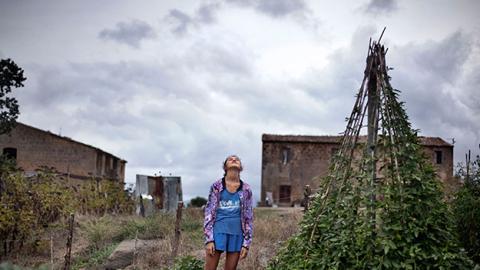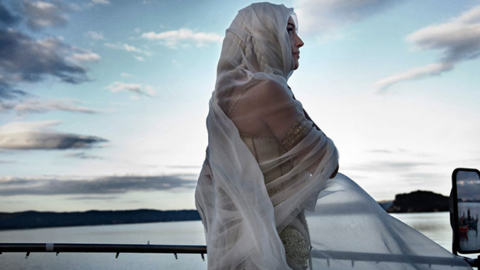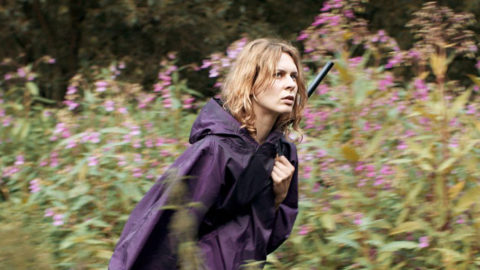
Hope for Us Yet
There are certain moments in the career of a filmmaker that illuminate not only their past movies but also the ones to come: the opening of Roberto Rossellini’s Rome, Open City, which, after his so-called Fascist Trilogy, signaled the director’s ideological and aesthetic awakening; the furious chasing shots in the prelude of Luc and Jean-Pierre Dardenne’s Rosetta, a sudden clarification of the severity and rigor of the Belgian brothers’ filmic vision after La Promesse; or the monumental wordless prologue of Paul Thomas Anderson’s There Will Be Blood, which inaugurated the director’s critical exploration of American history.
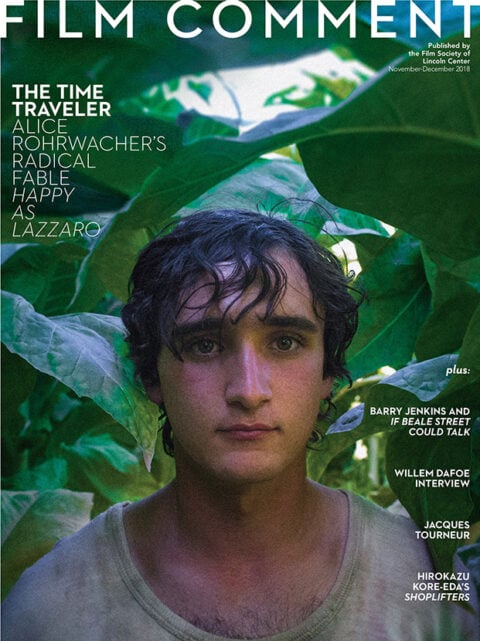
Contrary to these filmic rebirths—moments of stylistic and thematic expansion rather than turning points—the crucial revelatory moment in Alice Rohrwacher’s oeuvre doesn’t emerge at the beginning of a film, but at the end. The final two scenes in The Wonders (2014), each conceived as a departure from naturalism into earthly fantasy, take the shape of transitional shots. In the film’s second-to-last scene, after the young Gelsomina (Maria Alexandra Lungu), the eldest daughter of a family of beekeepers, tracks down their missing foster child, Martin (Luis Huilca), the camera pans from the boy, who sleeps stretched out on the floor of a cave lit by a campfire, up to the walls where the shadows of some kids, probably Gelsomina and Martin, play around before the camera pans back down to the slumbering boy. Within a single camera movement, the coming-of-age narrative—Rohrwacher’s favorite—turns into a lyrical conundrum: after this bewitching celebration of childlike playfulness, with shadows evoking Plato’s Cave, Martin vanishes from the movie and Gelsomina is left in a state of serene self-assurance, after spending most of the film embroiled in excessive responsibilities and unattainable desires.
The next and final scene in The Wonders finds Gelsomina coming back to the family’s farm in a state of emergent maturity. There the young heroine encounters the whole clan, including Cocò (Sabine Timoteo), a friend of her parents, huddled on a bed outdoors, an unsurprising sight given the post-hippie communal air of the family’s dynamics. Gelsomina joins the embrace of the bunch, and Cocò suggests the possibility of “hiding a secret in the house” for someone to discover in the future. Then the camera repeats the back-and-forth panning from the previous scene, this time to a camel, flamboyantly purchased by the father, and back to the outdoor bed—but now the family has vanished along with the mattress, leaving only the metallic base and the remains of a house in ruins. Conveying two disparate time periods in a single take, Rohrwacher conjures up the notion of personal memory and a profound sense of loss—not a paradise lost, just cherished experiences and emotions. She eludes nostalgia through the scene’s loose but poignant political stance in favor of preserving an alternative social organization to the dominant capitalist model.
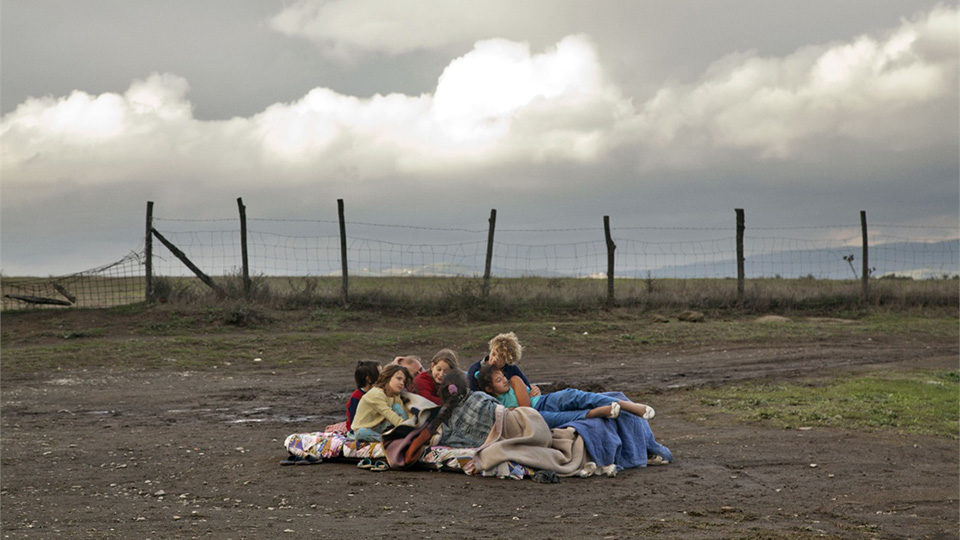
The Wonders
The unexpected transitions within the final shots of The Wonders—between reality and fantasy, and wakefulness and dreams in the former; and between the past and the present in the latter—are an inspired expression of an interest in the dialectics of transformation and stasis that has come to define Rohrwacher’s career. Corpo Celeste (2011), her first narrative film, is a study in metamorphosis—of a girl’s body, of a group of youngsters facing their Christian Confirmation, of a priest losing his faith—set against the backdrop of institutions (the church, the political establishment, the family) and an entire nation that are stuck in time. Happy as Lazzaro—Rohrwacher’s third and best feature to date—is the fable of an angelic boy, a holy fool, who travels unchanged from the countryside to the city, from not-so-ancient times to the present, and witnesses the perpetuation of marginality, moral corruption, and the exploitation of those in need by the powers that be. The film’s structural scission—a wondrous time breach, the seed of which lies in those concluding shots of The Wonders—fuels the revolutionary spirit of a movie that asks a simple, urgent question: how and why did we stop embracing and admiring goodness and beauty?
Toward the end of Pier Paolo Pasolini’s Oedipus Rex, the title character of Sophocles’s tragedy (this time incarnated by Franco Citti) is suddenly transported, along with his naïf sidekick Angelo (Ninetto Davoli), from a mythological past to the Italy of the 1960s, a time and place stricken by what Pasolini considered a profound moral crisis. Oedipus, condemned to blindness after puncturing his own eyes, becomes the tragic, powerless witness to a confusing present, while Angelo, with his everlasting childish cheerfulness, embodies the primal memory of an innocence lost. Several of the ideas that crystallize in Oedipus Rex’s epilogue reemerge in Happy as Lazzaro, which won Best Screenplay at this year’s Cannes Film Festival (following the Grand Jury Prize earned by The Wonders four years earlier).
Bisected by an elliptical, cosmic fracture, Rohrwacher’s new film takes the viewer from an indefinite past—in which an oppressed community of farmers live on a sharecropping estate—to a contemporary urban Italy marked by class stratification. The two locations denote a sort of uncertainty principle in Rohrwacher’s depiction of her settings—a sense of ambiguity about exactly when in history the action is taking place. The archaic, 19th-century look of the estate in Happy as Lazzaro’s first half, intensely recalling Ermanno Olmi’s The Tree of Wooden Clogs, is haunted by incongruity when Tancredi (played by pop singer and YouTube star Luca Chikovani), the spoiled son of the landowner Marchesa Alfonsina De Luna (Nicoletta Braschi), makes use of a cell phone. The same mobile technology used by Tancredi is employed by a priest in one of Corpo Celeste’s opening scenes, right in the middle of a half religious, half pagan procession that wouldn’t have been out of place in the Italy portrayed by Federico Fellini in the ’50s and ’60s. (It would be quite difficult to determine the decade in which The Wonders takes place if it weren’t for the recurrence of Ambra’s 1994 melodic-rap hit “T’appartengo,” a modern-day touch in a movie that plays ironically with the Etruscan roots of the setting and its people.)

Happy as Lazzaro
In fact, the idea for Happy as Lazzaro came to Rohrwacher, now 36, when remembering an article she had read in high school about an aristocrat’s tobacco farm, where peasants were still being exploited long after the final phasing out of sharecropping contracts in Italy in the early 1980s. She wrote the screenplay during a fellowship in New York as a filmmaker in residence for the Film Society of Lincoln Center. The creative indeterminacy of Rohrwacher’s settings extends to her rendering of urban landscapes on screen: the big city where Lazzaro ends up in Happy as Lazzaro’s second half is an amalgam of locations in Milan and Turin. The director’s fascination with the forsaken contemporary urban outskirts seems to mimic Pasolini’s approach to the slum-like borgate of Rome; the impoverished Reggio Calabria region in Southern Italy that Corpo Celeste’s young Marta spots from her terrace mirrors the shacks and dumping grounds that Mamma Roma’s young Ettore observes through his window. In short, past and present blur together in Rohrwacher’s vision of an Italy in stasis—a land where the incessant cycle of dispossession is fueled by the dogmas of faith and profit. It can’t be a coincidence that all three of Rohrwacher’s features begin with unlighted scenes in which religious devotees, hunters, or peasants wander seemingly lost in the dead of night.
A whole collection of uncertain realities, slightly out of time and place—lending the quality of myths, fables, and dreams—come together in the mesmerizing titular character of Happy as Lazzaro. Magnetically embodied by the newcomer Adriano Tardiolo, Lazzaro roams around in a permanent state of entrancement, serving anyone who asks for his help—whether the Marchesa, Tancredi, or his own peers—while completely unaware of his exploited condition. As a true archetype of sheer goodness, he responds with soulful generosity to a cynical world that can only see him as a simpleton. With his ivory-white rolled-up long-sleeve T-shirt and his wide brown trousers, launched from not-so-bygone days into a dark present, Lazzaro in his resilience brings to mind the mythical resonance that André Bazin perceived in the innocence of Chaplin’s Little Tramp—that universally recognizable estrangement that could touch hearts and awaken consciences.
The given names of Rohrwacher’s characters tend to be referential: Gelsomina in The Wonders evokes Fellini’s La Strada; Happy as Lazzaro’s Tancredi—who reappears in the movie’s second half (now played by Tommaso Ragno) as a decadent, disinherited aristocrat—calls back to the exiled and betrayed Syracusan soldier from Rossini’s opera, an adaptation of Voltaire’s Tancrède. And Lazzaro, feeding the film’s sense of biblical parable, conjures the miracle of Jesus restoring Lazarus’s life four days after his death, a time lapse altered by the anti-dogmatic Rohrwacher. Like Corpo Celeste, Happy as Lazzaro manifests the director’s mistrust of organized religions: in the film’s second half, when Lazzaro and his fellow ex-peasants, now petty thieves, are thrown out of a church by a protective nun, the organ music that’s being played follows them out, as if fleeing the house of God. But ultimately, with its free-flowing unorthodox narrative and its clear transpositions of the ordinary into the imaginary—one enigmatic voiceover turns the friendship of the young Lazzaro and Tancredi into a legendary battle of “knights”—Happy as Lazzaro feels closer to an experimental folk song than to a gospel. It’s not far from Apichatpong Weerasethakul’s stunning Mysterious Object at Noon, with its study of the merging of reality and fantasy in the formation of myths.

Happy as Lazzaro
By transcending the naturalism that prevailed in Rohrwacher’s previous films, Happy as Lazzaro becomes its own kind of mysterious object. Although Corpo Celeste and The Wonders were likewise shot on Super 16mm by Hélène Louvart, here the same format’s pre-digital grainy texture enhances not so much a neorealist sensibility or a documentary style but a rarefied sensuousness that reveals, through a sort of detachment, the essence of the human spirit and the corruption of social life. By invoking magical realism, Rohrwacher emancipates memory from nostalgia, while the unusual vigor of her images is reinforced by the sound and editing. The cacophonous rush of voices demanding Lazzaro’s help in the fields and a buzzing sound that seems to come from nowhere are sonic evidence of Rohrwacher’s non-realist approach to filmmaking. Happy as Lazzaro lavishes the viewer with an unexpected cut from a sunny location to a snowy landscape, while the minimalism of an interior choral scene in the sharecropping estate, lighted with a single bulb placed in the frame, sets up a wild dichotomy with the later monumental aerial shots that help split the movie in two. If the film has an expressive mantra, it’s the title of the young Tancredi’s favorite dance-floor song, the 1994 hit “Dreams (Will Come Alive),” by Dutch Euro-dance duo 2 Brothers on the 4th Floor.
The entrancement induced by Happy as Lazzaro’s images seems to emanate from the particular connection between Rohrwacher and Lazzaro’s sensibilities. The filmmaker shares Lazzaro’s values but not his naïveté: she distances herself from the film’s hero to observe the chain of exploitation that has propelled modern forms of feudalism. One can feel (and share) Rohrwacher’s outrage, but fortunately that doesn’t prevent her from admiring the beauty that radiates from Lazzaro. Among the unforgettable gestures captured in the film are the excitement of two teenagers kissing passionately amidst tobacco plants and the eagerness of Antonia, a former maid of the Marchesa (played by Alba Rohrwacher, the director’s sister), when she buys a 50-euro tray of pastries to treat her past masters—an example of the generosity of those who have nothing but are willing to give everything. Such tenderness—in all his self-sufficiency, the adult Tancredi is more a clownish dandy than a resentful bully—functions as an antidote against moralism and is the result of the director’s affective proximity to her characters.
It is through the eyes of her young protagonists that Rohrwacher captures the essence of Italian reality and its popular imagination, a cultural amalgam both exalted and dispiriting, colorful and miasmic. Through the curious, startled gaze of her uncorrupted heroes, Rohrwacher renders as pure, intentional chaos the connivance of the church, the political classes, the media, and the financial world in the governance of the state. In Corpo Celeste, when the 13-year-old Marta looks at the TV news, instead of listening to the political commentary, she can only focus—as revealed by a subjective close-up—on the anchorwoman’s cleavage, which is adorned with a prominent golden Christian cross. In The Wonders, Gelsomina can’t take her eyes off Milly (Monica Bellucci), the dazzling host of a TV talent show that promises wealth and popularity to local farmers, but when the televised goddess takes off her fabulous white wig in front of the girl, the simulacrum of joy bursts into utter sadness.
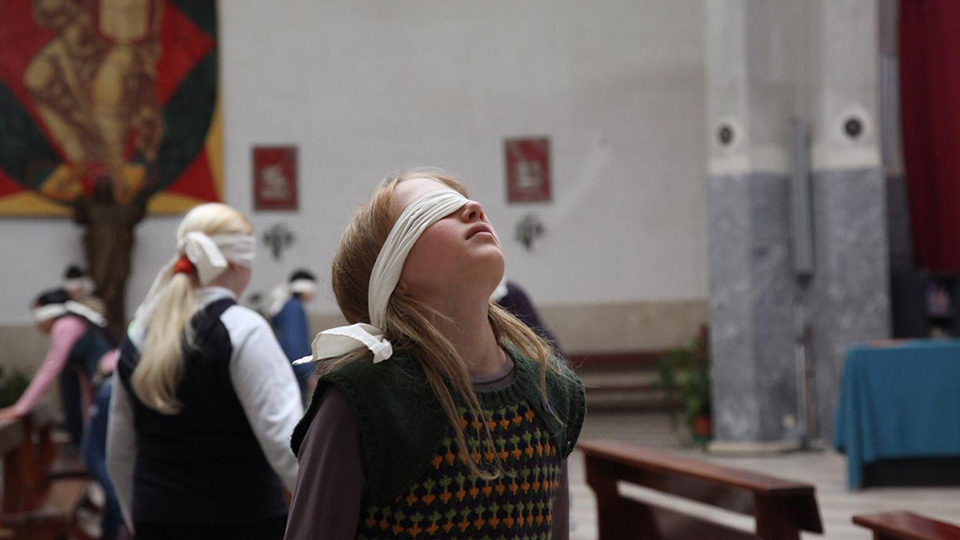
Corpo Celeste
It’s a touching moment of truth that points to the emotional and moral void that, in Rohrwacher’s eyes, keeps Italy submerged in Debordian spectacle: kids’ beauty pageants and kitsch Confirmation ceremonies in Corpo Celeste, the talent show in The Wonders, and, in Happy as Lazzaro, the anachronistic feudal fantasy of the film’s first half and, most disturbingly, a shameful modern slavery market in which foreign workers bid for shifts in a reverse auction. Asked about the film’s contemporary resonance during a Q&A in New York, Rohrwacher said: “What Lazzaro represents is . . . something that we could recognize ourselves in, in terms of what we were in the past—when we were children as human beings and also when mankind was in a younger age. In terms of the relation with contemporary Italy, when he falls off the cliff, this is what happened to my country over the past 30 years. I feel that there was a past which wasn’t all flowery goodness, it was a past characterized by abuses and by exploitation, but there was still a connection there. And after this fall it’s as if there was a sudden break. The contemporary world developed, everything has changed; however, the dynamics that run it are the same. So the peasants of the past are now replaced by a new class of slaves.”
Rohrwacher’s dissection of a nation on the verge of moral bankruptcy is not at odds with the possibilities of comedy: ironic in Corpo Celeste, where in a nod to Chaplin (The Idle Class), the figure of a priest ceremoniously bowing in front of cross reveals a mundane act of turning off the church’s lights; blunt in The Wonders, with the rebellious father (Sam Louwyck) ridiculously confronting a group of hunters by shouting at them from afar while in underpants, recalling Graham Chapman’s clumsy theatricals in The Life of Brian; and warmhearted in Happy as Lazzaro, where the petty thief played by Sergi López bursts into incredulous wonderment when Lazzaro, with his ancestral and natural wisdom, teaches him about the edible plants growing at the edge of the railway.
Kindness and understanding: two pillars that, along with a rejection of normal modes of narrative filmmaking, are the foundations of Happy as Lazzaro’s unreconciled soul. Indifferent to the misanthropic trend prevalent in today’s cinema, Rohrwacher’s beautiful, painful movie alerts us to the maladies of our time while also providing us with the emotional tools to defeat them.
Closer Look: Happy as Lazzaro opens on November 30.
Manu Yáñez Murillo is a film critic and journalist, and has written for Fotogramas, Rockdelux, Ara, and Otros Cines Europa. He is the editor of the anthology La mirada americana: 50 años de Film Comment



